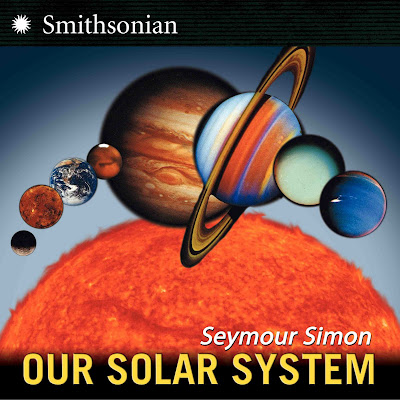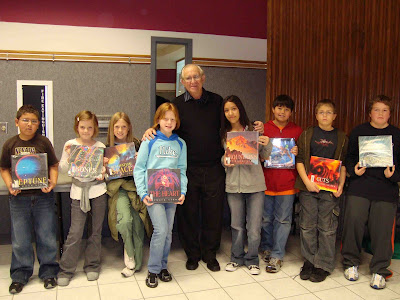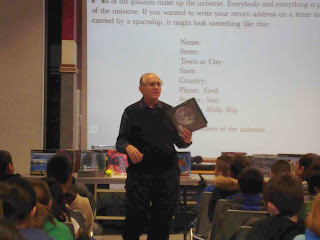Label: Space Books
August 26, 2010
Getting in touch with the Astronomer who demoted Pluto!
Posted by: Seymour Simon
March 26, 2010
Questions about the sun from Spencer G.

Hi my name is Spencer G. and I am doing a research project for school. I told my mom I wanted to interview you for my ‘Origins of the Sun’ project. I could not believe it when she told me she had gotten in touch with you and to leve my questions here for you!
1. What role did the sun play in the formation of the Milkyway?
2. What role did the planets play in the formation of the sun?
3. What role diddid the sun play in the formation of the planets?
4. What role did the stars, (other then the sun,) play in the formation of the sun?
Thanks so much for answering!
Hi Spencer! Good for you to be doing research on a project like this!
Briefly, our sun is only one tiny star in the billions of stars that make up the Milky Way Galaxy. So the question might really be the reverse: How was the sun (and all the other stars) born in the Milky Way Galaxy? Stars (like the sun) are constantly being born in spots called "star nurseries" in galaxies.
The planets were formed in a somewhat different manner and that is also rather complex. Again briefly, the planets formed from hot gases similar to the sun, but the gases cooled, other elements formed from the gases that were cooling and the planets were born. Finally, the other stars really had no role in the formation of our own sun. All the stars (including the sun) were formed in the same manner.
Hope this helps starting your research Spencer! Good luck on your project. You will be able to find more information in my books: THE SUN and OUR SOLAR SYSTEM. You should be able to find these books in your school library, or your local public library.
Good luck with your report!
Posted by: Seymour Simon
March 13, 2010
The Moon

Just this morning I received two copies of the latest (number 8) print run from Simon & Schuster of my book THE MOON. I’m so pleased at this. The B&W original of this book was first published by Four Winds Press (Scholastic) more than 20 years ago. Norma Jean Sawicki was the editor at that time and Brenda Bowen was her (very young) assistant. Brenda and I took a whole day talking about and making changes to EARTH and THE MOON. I remember that session very well (I had a headache by the time Brenda consented to let me go home). Years later, Brenda was the head of S&S children’s book division when we decided to update the book and this time in full color. The book is just beautiful and I’m so glad that it’s still timely. I have been so lucky with the people I’ve worked with in publishing! Thanks to all of them!
Posted by: Seymour Simon
February 25, 2010
A Visit to San Angelo, Texas
I was recently in San Angelo, Texas, where it was cold and raining and everyone was very happy about the weather. When you live in a drought-prone area like West Texas, I can understand why rain is a welcome event!
We (my wife Liz Nealon went with me) discovered that although San Angelo is a rather small city, there is a lot to see there. We visited the San Angelo Museum of Fine Arts, which is a gorgeous building with a permanent ceramics and silver collection that we enjoyed very much. We had lunch in historic San Angelo, at a restaurant called Miss Hattie’s Saloon, which had…let’s call it a "colorful" history in bygone days! And, we visited Fort Concho, where Pecos Bill was once the commander. The fort is a National Historic Landmark because it was the the home of the Buffalo Soldiers who were part of the 10th Cavalry, one of the two all-Black cavalry regiments who protected the Great Plains in the mid-1800s.
I was in San Angelo to speak at the 8th Annual Literacy Conference, held at Angelo State University. While I was there, I also spoke to a number of large groups of kids from the public schools in San Angelo. Here is a picture of me with a group of students from Holiman Elementary.
The kids were all bright, eager, and very smart. I told each group a story that is in one of my early books, THE LONG VIEW INTO SPACE, about the way I started writing my return address when I was their age. Here’s how I did it.
Name
Street Address
City
State
Zip Code
Planet Earth
Solar System
The Milky Way Galaxy
The Universe
Years ago, when this book first came out, I was on my way to visit a school in Ohio. I got a letter from a fifth grade boy who had been looking at this address, and told me that I forgot to put down the zip code for the universe. I asked the kids in San Angelo if they could guess what he thought the zip code for the universe should be. A student came up with the answer in every group I spoke to. They suggested that the zip code for the Universe should be ∞ - the symbol for infinity.
Try writing your complete address. You are truly a citizen of the universe (and make sure to include its zip code).
Posted by: Seymour Simon
July 21, 2009
Comet may have hit Jupiter - Rare Photographs
Comet may have hit Jupiter - Rare Photographs
There are news reports today that a comet slammed into the planet Jupiter on Monday. Scientists have drawn this conclusion based on images captured by NASA’s Infrared Telescope Facility on Hawaii.This is not the first time this has happened. In my book, DESTINATION JUPITER,

Posted by: Seymour Simon
March 9, 2009
Kepler - A Search for Habitable Planets
Are there are Earth-like planets in outer space? The Kepler mission aims to find out. We’re looking for a "Goldilocks" planet—not too hot and not too cold.
Posted by: Seymour Simon
January 30, 2009
JUPITER, 399 YEARS AFTER GALILEO

Nearly 400 years ago, Italian astronomer Galileo Galilei constructed a tiny astronomical telescope and looked at the night sky. He peered at the planet Jupiter, then a strange and mysterious object. Galileo discovered three faint dots around the planet and wondered what they might be.
Over the following year, Galileo observed Jupiter and these tiny pin-pricks of light. He discovered a fourth and saw that they were in motion around Jupiter. Could they be moons, other worlds in their own right? Galileo had discovered the first satellites circling around a planet other than our own. In future years they were named Io, Europa, Ganymede and Callisto. They are now known as the Galilean Satellites, in honour of the great scientist.
Galileo realized that these four moons were orbiting Jupiter. His observations cast doubt on the accepted view (at that time) that the Earth was the center of the Universe. Years later, the Galilean moons would be used by science to support Copernicus’s theory of a heliocentric, sun-centered universe, which we now know is much closer to the truth.
With a small telescope or a pair of binoculars, you too can see Jupiter and its moons, much as Galileo did nearly 400 years ago. On a crisp and cloudless night, find a safe and dark location to look to the night sky. The best places to look at the sky are away from street lights. The best observing time for Jupiter this year is in the summer. Jupiter is bright during the month of August, making this a good time to view its moons.
Focus your telescope or binoculars on Jupiter and try to pick out the dots of light on either side. These are the moons, just as Galileo saw them! You can even track their positions over consecutive nights, as he did. Even if you don’t observe Jupiter and the Galilean moons during 2009, it’s still worth looking up on a starry night and remembering how, nearly 400 years ago, history was made by Galileo doing the same thing.
Posted by: Seymour Simon


